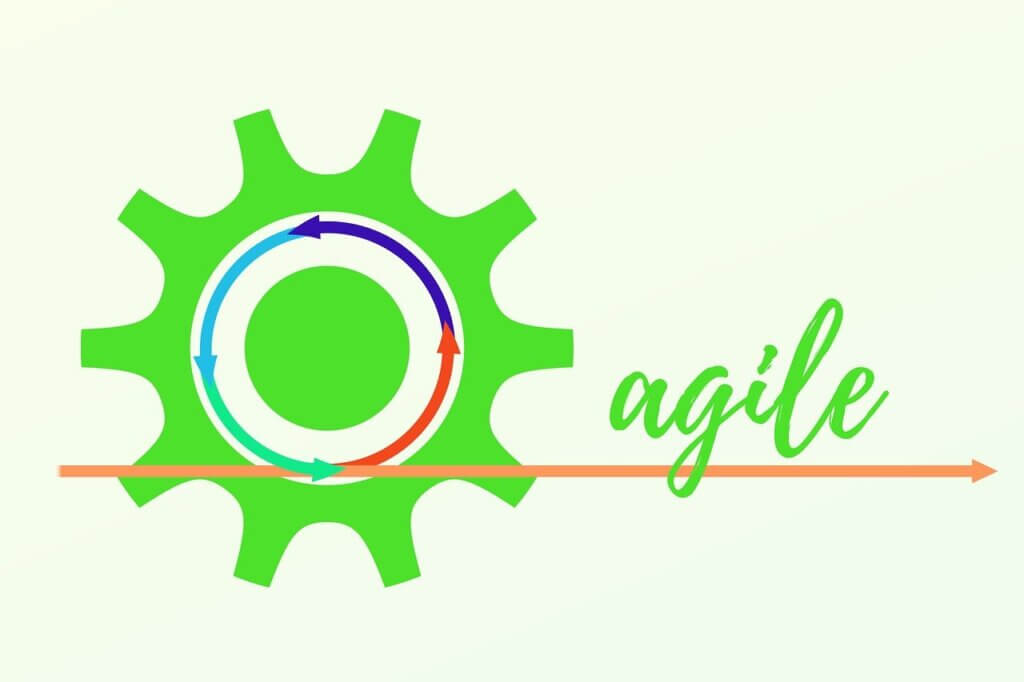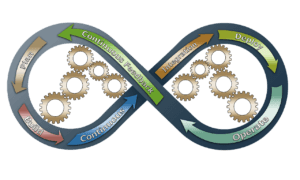After reading this article, you’ll:
- Understand the Agile methodology’s principles, practices, and core values, and how its iterative, incremental approach significantly benefits healthcare software development through flexibility, responsiveness, and continuous improvement.
- Learn about the specific advantages of applying Agile methods in healthcare, including faster time-to-market for patient and provider apps, improved patient outcomes through more adaptive and user-focused applications, and increased alignment with real healthcare workflows and user needs.
- Recognize the importance of selecting a software development partner with deep Agile expertise, particularly for healthcare applications, to ensure projects are executed efficiently, meet user expectations, and can adapt swiftly to the dynamic healthcare industry’s evolving standards and technologies.

Agile software development has become a widely used approach for creating applications of all types with greater speed and adaptability to change. Originating in the 1990’s, Agile methods involve breaking down development into short, iterative cycles called sprints. Within each sprint, improvements and new features are coded and tested based on close collaboration between development teams and business stakeholders or end users.
In recent years, healthcare organizations have increasingly adopted Agile techniques to develop clinical and patient-focused applications. Compared to traditional waterfall development, Agile offers more flexibility to adapt these apps to evolving medical standards and technologies. The method also emphasizes close provider-developer coordination to ensure apps meet real healthcare workflow needs.
With pressure growing for healthcare to leverage software advances, from patient portals to medical IoT systems, Agile offers many advantages. As this article explores, Agile development enables faster time-to-deployment, increased responsiveness, and continuous improvement for healthcare apps. For medical teams looking to maximize the value of new software innovations, Agile methods merit strong consideration given the benefits highlighted below.
What is Agile Methodology?
Agile methodology refers to a set of software development principles and practices that focus on rapid iterations of work that deliver functional outcomes. It emphasizes breaking large projects into small manageable chunks, close collaboration between self-organizing teams and end users, and adapting to changes quickly.
The Agile approach is guided by four core values:
- Individuals and interactions over processes and tools
- Working software over comprehensive documentation
- Customer collaboration over contract negotiation
- Responding to change over following a plan
 Most critically, Agile relies on iterative and incremental delivery of software. Instead of long release cycles (i.e., the waterfall model), Agile breaks work into small manageable sprints, typically lasting 2-4 weeks. At the end of each sprint, a working product is delivered for stakeholder review and feedback. Through this continual cycle of development-feedback-improvements, the end product gets iteratively refined and enhanced over multiple sprints.
Most critically, Agile relies on iterative and incremental delivery of software. Instead of long release cycles (i.e., the waterfall model), Agile breaks work into small manageable sprints, typically lasting 2-4 weeks. At the end of each sprint, a working product is delivered for stakeholder review and feedback. Through this continual cycle of development-feedback-improvements, the end product gets iteratively refined and enhanced over multiple sprints.
This iterative approach enables faster problem identification, increases transparency, and allows for rapid adaptation to evolving requirements–critical capabilities in environments like healthcare where regulations and technologies are constantly advancing.
When to Use Agile?
Agile methods are best suited for projects with rapidly changing requirements, a need for faster results, and high levels of cross-functional collaboration. Software initiatives in dynamic industries like healthcare can benefit immensely from Agile development rather than traditional sequential approaches.
Specifically, Agile is recommended when:
- Requirements are likely to change over the project lifespan
- End-user feedback needs to be incorporated frequently
- Fast iterations and continuous delivery are priority
- Closer customer collaboration is required
- Future releases will build on previous functionality
- Quality needs to be assessed iteratively vs all-at-once
Benefits of Agile Software Development
 By breaking projects into iterative sprints and emphasizing transparency between teams and users, Agile software development provides many advantages–especially valuable in the rapidly evolving healthcare environment.
By breaking projects into iterative sprints and emphasizing transparency between teams and users, Agile software development provides many advantages–especially valuable in the rapidly evolving healthcare environment.
The sections below overview ten key benefits healthcare organizations can realize from embracing Agile techniques for their software projects. From accelerating time-to-deployment to reducing costs and improving quality, Agile enables more successful development of apps supporting medical workflows, patient engagement, data analytics, IoT systems, and other healthcare IT initiatives.
Faster Time-to-Market
Agile methodology emphasizes early and consistent delivery of working software through iterative sprints. Rather than waiting many months or years for a large-scale release, new features get deployed in a matter of weeks. This ability to bring functioning software to users faster provides a major competitive advantage.
Healthcare apps for patients and providers can get to market quicker using Agile techniques. The continual integration and user feedback help identify successes and required changes rapidly. As a result, health organizations can roll out minimum viable products in early sprints and then refine and augment functionality in subsequent iterations. This fail-fast approach with shorter cycles ultimately gets innovations deployed faster.
Improved Patient Outcomes
In addition to faster deployments, Agile development also enables stronger and more adaptive applications–leading to better patient experiences and health outcomes.
By using Agile techniques of frequent delivery and end-user feedback, healthcare app builders can continually refine UX and functionality to optimize patient usability. Agile’s flexible approach makes it easier to quickly incorporate new medical knowledge, technologies like AI/ML, or healthcare innovations to improve care. Apps can also promptly address areas negatively impacting patient use or engagement once identified.
Overall, Agile methods let healthcare apps evolve better functionalities for diagnosing, treating, monitoring, and managing various health conditions. The result is more use and trust in the tools supporting patients’ care journeys–driving adherence and better outcomes.
Better Alignment with User Needs
A core element of Agile development is close collaboration between the software teams and the end-users–whether patients, physicians, nurses, or other healthcare staff. Through interactive sessions, user feedback loops, observation of workflows, and immersion in the medical environment, Agile reinforces building what users actually need.
This connection ensures healthcare applications get aligned with both clinical protocols and processes and patient preferences. Unlike waterfall development, where months pass without user input, Agile builds in consumer-centric design from the start and refines the apps based on real healthcare insider input. The result is medical software that integrates more seamlessly into existing systems and delivers exponentially greater user satisfaction.
Increased Flexibility and Responsiveness
In contrast to waterfall development, Agile methodology is designed to embrace change during a project lifespan rather than follow a rigid pre-defined plan. This inherent flexibility enables greater responsiveness for healthcare applications where regulations, clinical insights, technologies, and patient expectations are constantly shifting.
Using Agile practices like regular stakeholder reviews and rapid re-prioritization of requirements backlogs, healthcare apps can promptly accommodate new use cases or modifications needed to sync with industry changes. Developers don’t have to start back at square one. This adaptability results in apps that can continuously meet evolving medical and consumer needs rather than quickly becoming outdated.
Higher Product Quality
Agile methodology builds quality into apps from the beginning and at every sprint through extensive testing, user reviews, and continuous integration principles. Unlike waterfall development, which relies on quality testing happening mostly at the end, Agile takes a test-often mindset.
With iterative delivery models, defects can be caught early before they cascade through the entire product. Usability issues and performance bottlenecks also get rapidly flagged through frequent user testing. Bugs and UX problems have dedicated time allocated every sprint to fix. This continual testing and user feedback results in more robust, higher-quality healthcare applications that provide solid reliability and experience.
Improved Team Communication and Collaboration
Agile methods are based on close-knit cross-functional teams that enhance transparency, information sharing, and ownership of the project vision. Unlike siloed waterfall development, Agile team members participate in all aspects from planning to testing. This collaborative structure and daily standups create tighter bonds between product managers, developers, QA staff, end-users, and other stakeholders.
For healthcare software, Agile facilitates better knowledge transfer across medical domains and technology specialties. More productive coordination also minimizes misalignments so apps fulfill clinical, patient, and technical needs. Overall, Agile improves working relationships, productivity, and ultimately higher team “velocity” in delivering new application capabilities.
Reduced Risk
Agile software development lowers risk compared to traditional waterfall approaches through its emphasis on incremental deliveries and continual feedback. Each sprint produces a working product build that stakeholders can evaluate early, determining if the project is headed in the right direction. This transparency enables course correction before significant time and money gets wasted on misguided efforts.
Additionally, Agile doesn’t require all project requirements to be specified upfront when the least is known. By deferring details until the appropriate sprint planning, applications mitigate the risk of overinvesting in capabilities that later prove less valuable. Gradual progress also lets teams build knowledge before committing to bigger complex features. For healthcare’s dynamic landscape, Agile provides insurance against unforeseen industry shifts.
Overall, Agile’s iterative building and inspection process significantly reduces risk factors in application development.
Cost Savings
The ability to regularly re-plan priorities using Agile methods also optimizes cost-efficiency in the development process. Features providing less clinical or patient value can get deprioritized or descoped if newer needs emerge or budgets tighten. Unused application components don’t get built.
Additionally, Agile’s focus on user-centric design means apps solve real medical problems vs. indulging “nice to have” functionality. By ensuring every sprint delivers maximum value, waste gets minimized across the entire project lifecycle. Combined with faster time to market, this cost control helps healthcare innovations achieve better ROI.
Frequent Customer Feedback
Agile methods provide recurring touchpoints with end-users through demonstrations, pilot testing, and feedback capture during each sprint interval. This continual user input helps guide applications to best satisfy needs while identifying areas of improvement early.
For healthcare software, getting regular feedback from patients, doctors, billing staff, and more ensures apps meet expectations around medical workflows, care coordination, diagnostics, and more. Quick patient surveys can capture evolving needs on engagement, support services, and user experience. Seamless mechanisms to submit comments mean product teams can promptly address issues or enhancements requested by healthcare organizations.
This collaborative relationship sustainably delivers more value by aligning application capabilities tightly with patient and provider priorities throughout development.
Continuous Delivery and Improvement
The iterative approach in Agile provides the means for continuous delivery of new features along with continual quality and performance refinements. At the end of every sprint, end-users gain access to newly developed working functionality.
For healthcare applications, this means clinicians and patients get to benefit from the latest medical or technology advancements faster without waiting months for a major release. It also allows applications to keep pace with evolving care standards, device integration needs, population health requirements, and patient preferences.
Combined with feedback loops, this steady addition of valuable functionality framed within quality enhancements establishes a cycle of continuous improvement for healthcare apps.
Finding a Software Development Company Who Uses Agile Methods
Given the many benefits Agile development offers for healthcare applications, medical organizations should seek out providers with expertise in these techniques. Here are the best practices for identifying the right software vendor:
- Ask specifically about their Agile capabilities – how long have they practiced these methods, on what types of projects, what frameworks like Scrum or Kanban do they follow?
- Validate how they incorporate user feedback within rapid iterations and facilitate close collaboration between development teams and product owners.
- Assess the ability to release functional software frequently, not just at the end of long dev cycles.
- Confirm they can provide metrics on team velocity, sprint burndowns, and defect rates that reflect Agile results.
- Inquire about training programs, certifications and culture shifts that support cross-functional Agile delivery from executives to engineers.
- Request client examples specifically for healthcare apps built successfully using Agile practices.
The right partner will showcase profound depth in all aspects of Agile software development, from people to process. This process will ensure healthcare IT projects realize the full benefits and responsive partnership that an Agile approach enables.
By embracing Agile methodologies, healthcare organizations can maximize the effectiveness of their technology investments and partnerships. As outlined above, Agile’s iterative building process unlocks faster deployments, continuous alignment with user priorities, executive transparency for decision-making, and the ability to shift quickly based on industry disruptions.
Investing in these capabilities provides a potent formula for healthcare to extract the most medical and consumer value from their mobile, web, and other applications–both now and well into the future.
Frequently Asked Questions (FAQs) on Agile Software Development in Healthcare
What is Agile Methodology in the context of healthcare software development?
Agile methodology in healthcare software development refers to a set of principles and practices focusing on rapid, iterative work cycles that deliver functional outcomes. It prioritizes breaking down large projects into smaller, manageable sprints, fostering close collaboration between cross-functional teams and end-users, and quickly adapting to changes. This approach ensures healthcare applications can evolve to meet changing medical standards and user needs efficiently.
Why is Agile methodology particularly beneficial for healthcare applications?
Agile methodology is especially beneficial for healthcare applications because it offers the flexibility to adapt apps to evolving medical standards and technologies quickly. It emphasizes close collaboration with healthcare providers to ensure that applications meet real workflow needs, enabling faster time-to-deployment, increased responsiveness, and continuous improvement, which are critical in the fast-paced and constantly changing healthcare sector.
How does Agile methodology improve patient outcomes?
Agile methodology improves patient outcomes by enabling the continuous refinement and enhancement of healthcare apps based on frequent delivery and end-user feedback. This allows for quick incorporation of new medical knowledge, technologies, or innovations, leading to better functionalities for diagnosing, treating, monitoring, and managing health conditions, ultimately enhancing patient engagement and adherence.
What makes Agile suited for projects in dynamic industries like healthcare?
Agile is suited for projects in dynamic industries like healthcare because it is designed to handle rapidly changing requirements and incorporate end-user feedback frequently. Its iterative nature allows for fast iterations and continuous delivery, making it easier to adapt to industry changes, incorporate the latest medical insights, and ensure closer collaboration between developers and healthcare professionals.
How does Agile methodology lead to higher product quality in healthcare apps?
Agile methodology leads to higher product quality in healthcare apps through its test-often mindset and continuous integration principles. By incorporating extensive testing, user reviews, and feedback at every stage of development, Agile helps catch defects early, improve usability, and address performance bottlenecks. This iterative testing and refinement result in robust, reliable healthcare applications that provide a solid user experience.





